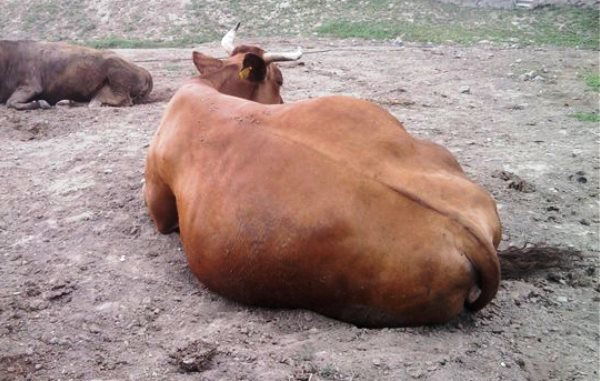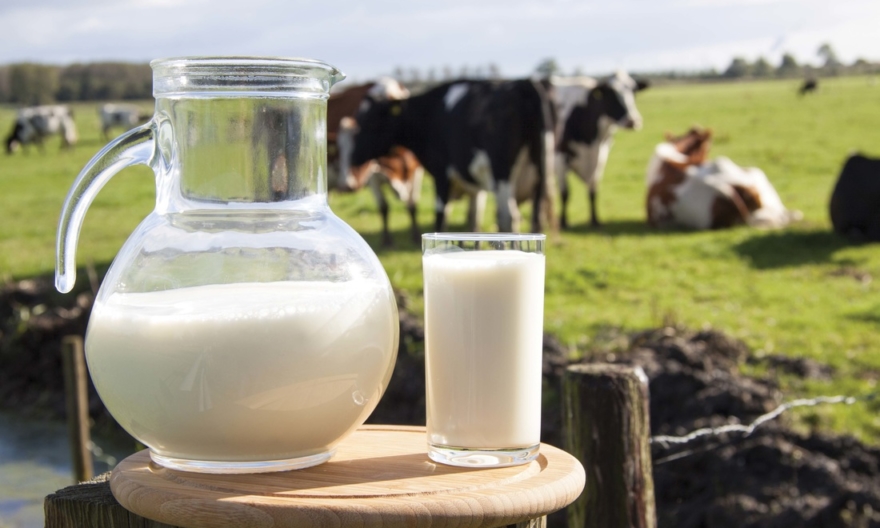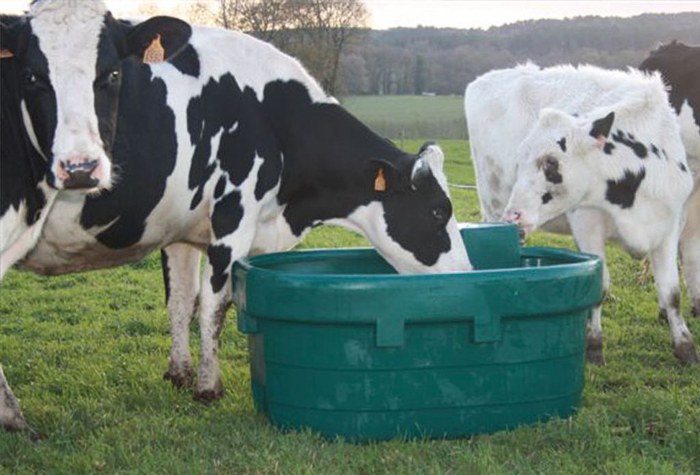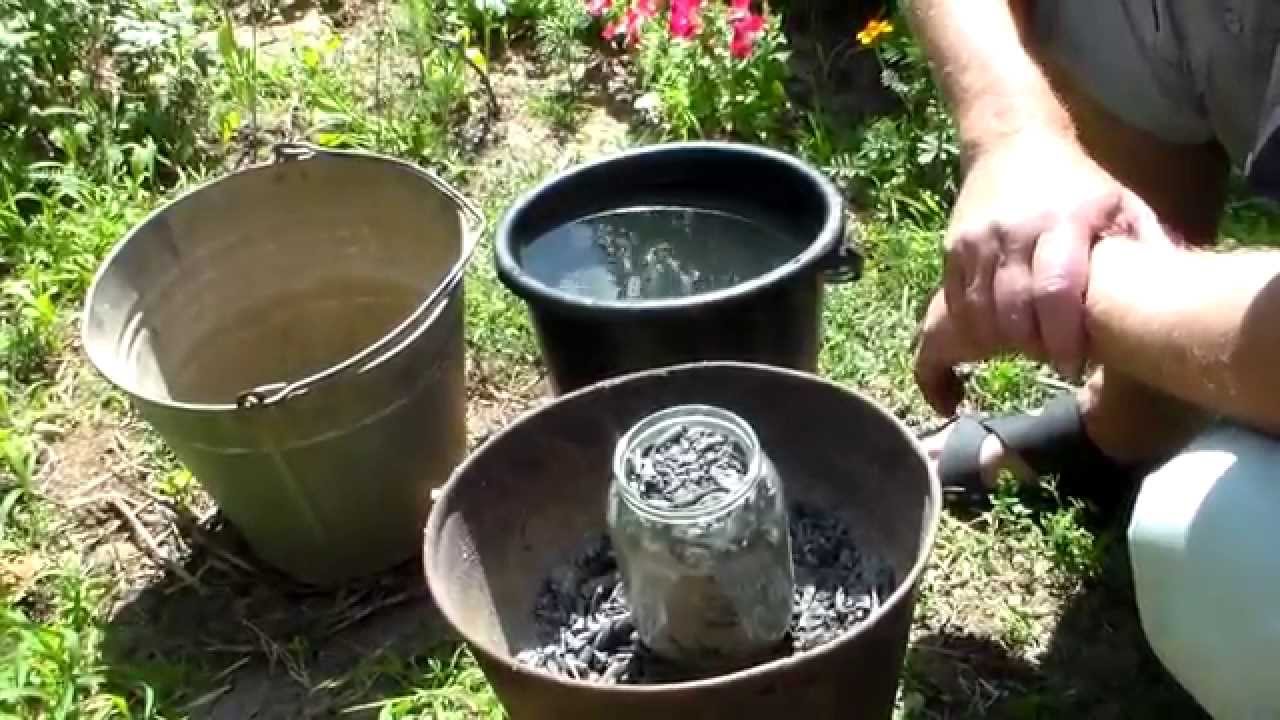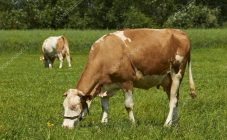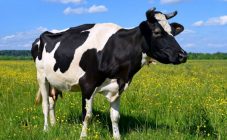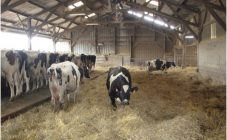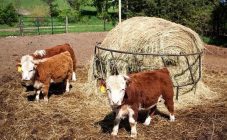Tympania of the rumen in cattle arises from the negligent attitude of the shepherd to the grazing regime. The illness is often acute, requiring emergency assistance. The history of tympania shows that if timely veterinary care is not provided, a lethal outcome is possible.
Tympania reasons
Tympania of a cow's scar is a non-communicable disease, a symptom of which is an enlarged scar, a large pancreatic region on the left side of the body. Inexperienced breeders should know which part of a cow is a rumen. This is the largest section of the cow's stomach, with a volume of 200 liters. It is located on the left side, from the diaphragm to the pelvic region.
The main cause of the disease is the rapidly developing gas formation in the rumen cavity and the impossibility of gas discharge. As a result, the scar begins to swell. The most susceptible to tympania are representatives of cattle, rarely goats and sheep, camels.
An enlarged cow's scar compresses the lungs as well as the heart. The rapid progress of tympanic disease leads to asphyxia (cessation of the cow's breathing), cardiovascular failure. Death occurs within 2-3 hours. Tympania is massive. The most frequent cases were recorded in adult cows.
The causes of tympanic disease:
- eating poor-quality, wet, stale feed;
- the diet consists of a large amount of concentrated grain feed;
- obstruction of the esophagus with a foreign object;
- acute infectious diseases;
- poisoning with poisonous plants;
- traumatic reticulitis;
- blockage of the book (3rd section of the four-chamber stomach);
- liver disease.
Pathogenesis of the disease
During normal rumen operation, the food eaten by the cow goes through all stages of digestion. In this case, gases are formed with high intensity. But bloating does not occur due to the burp reflex. One of the main clinical factors of tympania is a violation of the process of gas discharge from the rumen as a result of sphincter spasms and increased pressure in the proventriculus. The disease occurs due to poor quality, excessive volume of forage, water and gases.
Types of tympania
The acute form of tympania in cows is characterized by rapid gas production. The cause of the primary acute tympanic rumen is the eating of easily fermenting feed: corn (at the stage of milky-wax ripeness), alfalfa, vetch, clover, cabbage and beet leaves. If they get warm in a pile, get wet in the rain, they become especially harmful. Drinking plenty of fluids from the cow after consuming such feed also causes the food to swell in the rumen. Emergency help is needed.
Eating rotten root vegetables, frozen potatoes, spoiled grain leads to a slow-flowing tympanum.
Secondary tympania occurs in a cow after eating poisonous plants: aconite, a milestone of the poisonous, cicuta, crocus. Most often, paralysis of the scar wall, blockage of the esophagus, violation of the processes of belching and gum occur. In more rare cases, there are symptoms of intestinal obstruction, blockage of the book, acute febrile diseases.
The chronic form of tympania is characterized by a persistent violation of the functionality of the proventriculus. The cow suffers from chronic catarrh of the gastrointestinal tract, traumatic reticulitis.To alleviate the condition, it is required to eliminate the causes. In the absence of help, the cow becomes thin, stops producing milk, suffers from constipation. Its economic and breeding value is being lost.
Scar tympania in cattle can be of 2 types: gas and foamy. Foamy tympania is caused by eating large amounts of concentrated grain feed. Fermentation leads to the formation of foamy masses. This type of disease is more difficult to treat.
Why does a calf have a big belly? The causes of bloating can be artificial feeding, dysentery, paraffitis, intestinal infections and poisoning. Tympania in calves also begins when they switch from dairy to plant foods.
Tympanic symptoms
Primary symptoms of tympanic scar:
- the cow stops eating food;
- bloated abdomen;
- there is a protrusion of the left side;
- there is tension in the hungry fossa;
- cow's pronounced anxiety: mooing, looking at the stomach, beating legs, arching the back;
- change in behavior, the animal lies down and gets up many times;
- profuse salivation;
- breathing is rapid, chest, shallow, with coughing, groans;
- cyanosis (blue discoloration) of the mucous membranes;
- cold ears, limbs.
With further gas formation in the scar, a characteristic sign of the disease appears: the bulge of the left hungry fossa, the body becomes asymmetric. Where is the hungry hole in the cow? It is a clearly visible triangular depression in the pelvic area.
In the early stages of tympania, the cow has frequent belching, then it stops. Percussion of the scar zone produces a boxed sound. The tension of the walls of the scar is detected by palpation and pressure with fingers. The contractile activity of the scar is frequent at first, and then stops. The cow tries to defecate and urinate many times, producing small amounts of feces and urine.
Treatment
What if a calf has a swollen belly? Taking prompt action at the initial stage of the disease helps the animal. At the first sign, you need to take a number of measures:
- stop grazing on pastures unfavorable for the cow;
- form the correct diet from quality feed;
- massage the scar area;
- for the appearance of belching, bind (bandage) with a rope, a straw tourniquet, smeared with tar or ichthyol;
- belching can also be caused by the method of rhythmic stretching the tongue of the animal;
- lead the cow slowly up the slope;
- do cold water douches in the area of the left sigh, or lead the cow into the river.
An adult cow or a calf has a swollen belly, what should I do? A pronounced, acute form of tympania requires immediate complex measures:
- reducing the volume of accumulated gas;
- suppression of the fermentation reaction;
- elimination of poisons;
- normalization of the work of the cardiac and respiratory systems.
Gas removal is carried out by introducing a large caliber probe. It must pass through the mouth to the scar. The cow is placed in a position in which the frontal part of the body is elevated. At the same time, the swollen scar is massaged outside. After the emission of gases from the belly, the rumen is washed with plenty of water (up to 10 liters).
If a foreign body is found during the insertion of the probe, remove it. To do this, vegetable oil is poured into the throat of the cow so that the mash comes out on its own. You can try to remove the obstacle with your hands, a probe. If the passage is blocked by a boiled potato, then you need to crush it through the walls of the esophagus.
To neutralize the fermentation reaction, 1000 ml of a 2% aqueous solution of ichthyol or 50-100 ml of kerosene mixed with water is injected through a probe. To adsorb the accumulated gases, enter:
- 2-3 liters of fresh milk;
- 200-300 g.charcoal mixed with 2-3 liters of water;
- magnesium oxide.
For the treatment of foamy tympania in cows, foam-destroying, disinfecting agents, alcohol, oils, ammonia are used. To eliminate foam, FAMS is widely used, diluted with water in a ratio of 1:50, as well as Sicaden, Antiformol. The drug Tympanol, containing a silicone defoamer, helps well. The medicine is diluted with water in a ratio of 1:10 or 1:15.
You can also treat tympania in cows with folk remedies:
- a solution of vodka with water in a proportion of 250 ml to 0.5 liters;
- 10-20 ml of hellebore tincture;
- 50-200 ml of turpentine with vodka;
- infusions of chamomile, caraway seeds, dill, valerian.
When asphyxiation increases, you have to help the cow with an operation. The scar is punctured with a trocar in the region of the left hungry fossa. After opening, gases are released slowly, covering the puncture with cotton wool. Quick release of gas will cause the animal to faint. Anti-fermenting and antiseptic agents are introduced through the trocar sleeve. At the end of the procedure, the wound is treated with iodine and sealed with cotton wool moistened with collodion.
After the measures taken have eliminated the bloating in the calf, what to do next?
The cow is shown hunger for about a day. Then the animal is transferred to a sparing diet in the form of small portions of silage, hay and sugar beets 5-6 times a day, gradually introducing concentrates. In half a liter of water, dissolve 2 tbsp. tablespoons of hydrochloric acid and give the cow as a decongestant. To return the normal motility of the scar, you need to do massage, thermal procedures, and give the bitterness inside.
As a prophylaxis of the disease, it is worth excluding all conditions that cause tympania. It is recommended to feed the cows with coarse food (straw, hay) before walking on the pasture. The shepherd must make sure that the pets move a lot.
